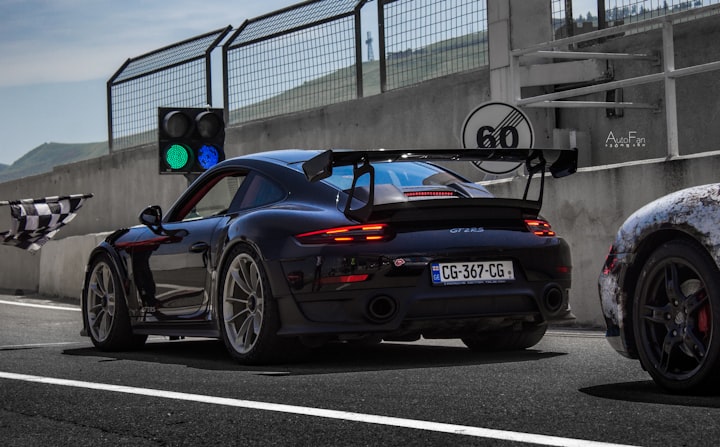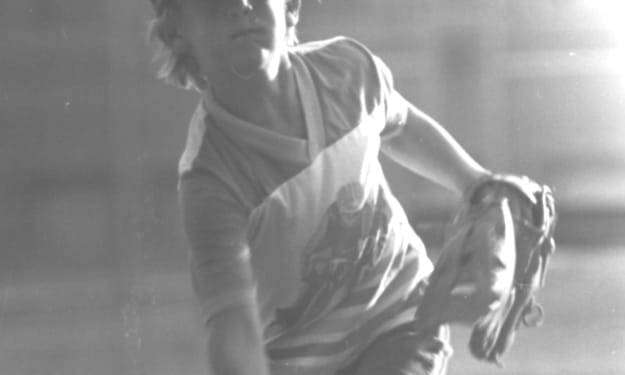Kind Of A Drag
Observations made by a newbie spectator, spending a day at the local drag races.
Dear Sophie,
Greetings from the parking lot of the Drag strip. You’ve seen the Marx Brothers’ movie – A Day At The Races (at least twice with me) and I know you have listened to Queen’s album – A Day At The Races, because you borrowed it from me about two years ago and you still haven’t given it back. What’s up with that? Anyway, I am going to complete the hat trick for you now by recounting the story of my very own day at the races – drag races that is!!!
The day snuck up on me at the first light of dawn. I managed a few stretches and yawns, put together a short strength routine, showered, and then headed out for cooler supplies – you know – sodas, ice, that sort of thing. I found my genuine, Canadian Tire issue Dale Earnhart Jr. camping chair – bright red, complete with the autograph and the big number eight on the back and threw it in the back of my truck along with my now-well-stocked cooler.
“Get your motor running, head out on the highway. Lookin’ for adventure . . . “
I drove up the dusty old airport road to the track. Once through the admission gates, I was directed to park out in the middle of nowhere –
“. . .in a big field of tall grass. I dreamed I was in a Hollywood movie . . . “
No, wait, that’s a different scene. I shut off the truck, hopped out, gathered my supplies and made my way from the alpine meadow down to the airport tarmac. The public address system blared a constant banter of race commentary. It could be heard literally a mile away. The guttural sounds of highly-modified and turbo-charged engines filled the vacant auditory slots between tidbits of narrative repartee. As I got closer to the track the air became thicker with the greasy, sour smell of peeled rubber from the earliest of the time trials. Each hot rod class racer did his or her best to deliver smoke and thunder to the audience through the completion of a burn-out at the entrance to the track. Tires cried and observers cheered. Smoke billowed and the audience applauded. Speeds of one hundred plus miles per hour were announced in 1/8 mile times of sub-seven seconds. All of this served as the sensorial matrix into which I intended to become immersed for the day. I was looking for the essence of being a first degree spectator of drag racing. I wanted to talk drag racing and smell drag racing. I wanted to see smoke and black marks on pavement and hear the loudest possible engine raps out there. I would eat hot dogs and drink Pepsi and urinate in public washroom troughs. I would get sunburned and feel dirty from the dust of cars parking and moving in and out of pits. I would spill mustard on my tee-shirt and leave it there for the day. I would root secretly for the Camaros and S-10s and the Impalas. I would go home feeling tired but not before I saw the last race of the day.
I wandered around some before settling in with some friends right there at track side. I couldn’t help but get caught up early in the culture of the event. Friends of drivers, their pit crews and their friends and families and the families of the drivers and the friends of the families of the drivers and the pit crew personnel filled the available space on the grounds at the venue. Girls with tight blue jean cut-offs and halter tops and guys with black AC/DC tee shirts and NHRA hats and wife beaters and flip flops and cowboy boots and grungy runners sat around in lawn chairs and drank sodas and ate sandwiches from huge camping coolers. I concluded that there is no set dress code for drag racing. The weather that day seemed to suit the clothing that found its way onto the backs and legs and arms and heads of the participants and spectators alike. Some spectators set up trade fair awnings and gazebos. Some lay on blankets and sleeping bags. All cheered and created a din that was completely drowned out at intermittent stages by the roar of leg pipes and customized exhaust systems hooked ceremoniously to oversized engines capable of powering airplanes or small cruise ships.
I watched pairing after pairing as Street Machines and Hot Rods performed their time trials. Best possible times would serve as dial-in times later in the elimination rounds. An electronic starting and timing system measured both the elapsed time (ET) of each car, truck or machine as it covered the 660 foot distance (1/8 mile) as well as its velocity. Really fast cars like the street rods, hot rods and exhibition cars could cover the distance anywhere from five to seven seconds and be traveling at speeds of 90 to 150 miles per hour when they broke the barrier at the finish. The ETs were then written on the front and driver’s side windows for future runs in the elimination rounds. Driver’s were not allowed to run in faster times than the times attained in the time trials and so indicated on their windows. If they did they were said to have broken out and were thus eliminated from further racing for the day. Unless, of course, their opponents broke out with a greater margin than they did – in which case the vehicle with the smallest break out time could advance to the next round of eliminations. In the early time trials the cars could race and then circle around to the Pit area and wait for their call to marshal up once again. In the later elimination rounds, winning cars were hot-lapped directly from their race run back into the marshalling lanes ready for their next run.
To race, the cars were called into the marshalling lanes by class (i.e. street machines, street rods A or B, hot rods or exhibition, which included the dragsters and funny cars and some really modified street-legal monsters) and then moved up car by car / pair by pair until they were on deck for the start line. Prior to coming to the line cars could opt to burn out on the pre-start. The burn out helped to warm tires for better traction and grip on the actual start and race but it was more for the gear-junkie, race enthusiasts in the audience who lived for the smell of burning rubber, the screaming sound of tire on pavement and the sight of thick white smoke and steam as the tires spun to evaporate the water sprayed onto the burn-out area and eventually attempt to do the same to the pavement beneath. As the cars were manually lined up at the start their front tires would interrupt a light beam. As long as the tire was in the line of the beam the starting tree would indicate that the car was in place (i.e. it was staged). If the car rolled too far forward, the tire would move ahead of the beam and it would no longer be interrupted and the car would no longer be staged and it would have to back up and get staged again. As soon as both cars were first and second staged, the lights on the starting tree would turn on, in sequence from top to bottom and in ½ second intervals. The last light to turn on would be the green light at the bottom. As soon as the green light flashed the car in that lane would take off toward the finish line. It would be hoped all tires and wheels would be pointing straight ahead when take off occurred because if they weren’t it was difficult to steer the car under control as acceleration occurred. The tree lights are paired vertically and there is one column for each of the two lanes. If a car takes off and thus violates the staging prior to the green light, a red light will appear in place of the green light. A red light will also appear if the driver’s reaction time is less than ½ second – in other words, if a car takes off quicker than one half second after the green light appears it is deemed as humanly impossible as far as reaction time and car response time is concerned so the red light occurs. Now, in the time trials the red light does not come into play. A car’s time and velocity can still be recorded as the violation of the staging is all that is required to start the clock for that car. When the front tire breaks the light beam on the finish line, the clock stops for that car. A computerized radar system at the finish line also measures instantaneous velocity. All statistics are displayed immediately for the public address announcer so that he/she can pass them on to the crowd. In the elimination rounds however, a red light means disqualification for that car. Cars are also handicapped in the elimination rounds. The tree lights will start anywhere from a fraction of a second to several seconds sooner for the slower car in the pairing. The faster car has to chase down and pass the slower car in order to win the pairing and advance to the next round of the eliminations. If a car loses it can go directly back to the pits for trailering. If a car wins the pairing it is hot-lapped into the marshalling lanes for the next round. Usually, a company or individual will sponsor the one or both of the lanes so that their name will be used each time a race is called and the cars are identified for the audience (i.e. the ’68 Camaro driven by John Smith is running in the Ken Mac lane and he will be up against the ’69 Dodge Charger driven by Tom Jones in the Coastal Tire lane on the far side). Of course, sandwiches and sodas must be consumed in vast quantities while the races take place. Commentary and analyses and debate and humorous anecdotes are also commonplace. Name dropping, notable experiential recollection and bragging also occur with some regularity. Some sleep, some read, some spray water on themselves, some use sun block or apply oil (not 10W30) to themselves at regular intervals. When the smell of burning rubber or the sweet aroma of ethanol or nitrous fuel and track dressing fades, the olfactorocity of burgers, fries, onions and barbeque coals takes over.
By late afternoon, when the last of the over-sized engines had powered out their last RPM, I decided there were two ways to look at the phenomenon of drag racing. I had, for the entire day, looked at it through the eyes of a participant / spectator and how I had become completely immersed in the culture of the activity and how I had totally enjoyed the experience. I totally understood that the whole drag-racing scene is indeed fueled by social stability and strength of culture, and that helped me to also understand why it continues, even though we all know, and all too well I might add, that such an event is a colossal violation of all that is environmentally sacred. The ecological ‘footprint’ left by this day is definitely an ‘odd double size’. This other vantage point from which I viewed the excitement of the day left me considering the fuel consumed in the first degree of the activity. Probably none of the owners or mechanics or drivers of racing vehicles pondered for long, the fuel economy or burn efficiency involved in their seven-second journey down the 1/8 mile track. But, being a bit of a Math nerd, I decided to ponder the situation, at least briefly.
On average, one litre of fuel would be burned by each car in each race. One hundred eighty races took place over the course of the day so, that means that three hundred sixty litres of fuel were burned just in racing. Another litre was burned by each car each time they idled to the start line and performed their burnouts. So 720 litres of fuel were burned by the participants. In the vicinity of 2000 people attended the event and they arrived in around 800 vehicles which all burned, on average, 3 litres of fuel to make the trip from wherever they started and where they would end up that day. This means another 2400 litres of fuel were burned for a total of over 3000 litres of fuel for one event. Four thousand cans and bottles of soda were consumed – half that number were not recycled. Each can requires 100 watt-seconds to manufacture and another 10 watt-seconds to fill with a liquid that requires 1000 watt-minutes to concoct. The fifteen hundred hot dogs and 2000 hamburgers that were sold necessitated the butchering of two cattle that required 2 tons of feed in their lifetime, 100 kilometers of travel to a packing plant, another 100 kilometers of travel to a retail outlet, 40 kilowatt-hours of energy to cook and serve and 4 hours of manpower to clean up after and dispose of in a landfill where the debris would take one hour to process by machines that would use five litres of fuel during the processing time – machines that were built with eight tons of steel and other metal alloys and which required three weeks to be manufactured by 200 meters of assembly line equipment and 30 people who ate 3 tons of groceries in that three weeks and used 4500 litres of gasoline to get to and from work during that time. So far the cars that ran in the drag races have not been mentioned. One hundred cars raced, each with a total manufacture time of three weeks and an energy cost of two megawatt-hours. The total energy consumed continues to escalate depending on what aspect of race day one wants to examine. There are concrete barriers, markers, computers and other electronics. There is lumber provided by forestry practices and the energy needs of carpenters that erected the out buildings on the grounds. The list goes on and becomes more intricate. One has to wonder if the ecological price paid is worth the cultural massaging of the day at the races? However, I then looked at some faces. Some smiling sunburned faces. Some grinning grease-smudged faces. Some chattering, whiskered and wrinkled faces. All faces observed, led me to conclude that indeed the day was worth it. Not one single face signaled distress over the vast quantities of energy swallowed by this single insignificant event. Not one voice complained about fuel consumption or wasted rubber or spilled soda or abandoned food wrappers. At the end of the day, the faces told me that there was only one way to look at this drag-race event. That was to say that everyone involved had made it. There were no losers – only winners. Perhaps Mother Earth had endured a bit of an environmental whipping, but mankind came out of the whole affair smelling like . . . well, smelling like a combination of sweat, oily rags, burnt rubber, cigarette smoke, fried onions and spilled coffee, which isn’t really too bad at all for a ‘Day At The Races’.
Sincerely,
Johnny
About the Creator
John Oliver Smith
Baby, son, brother, child, student, collector, farmer, photographer, player, uncle, coach, husband, student, writer, teacher, father, science guy, fan, coach, grandfather, comedian, traveler, chef, story-teller, driver, regular guy!!







Comments
There are no comments for this story
Be the first to respond and start the conversation.